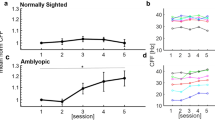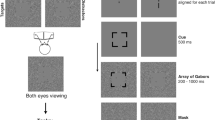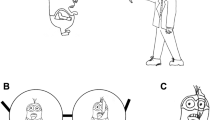Abstract
Amblyopia is a condition occurring at birth, or in early childhood, which affects up to 5% of the population and is characterized by degraded vision in one eye not able to be corrected by spectacles and having no observable lesion in the eye itself. Its cause is therefore uncertain, yet indirect evidence suggests a neural one, very likely in the visual areas of the brain. Ambyopia is usually associated with either a strabismus (eye misalignment) or anisometropia (unequal refractive error). Investigation into its neural basis has involved two approaches: psychophysical research in humans with amblyopia1–6 has shown marked contrast deficits for threshold stimuli, suggesting deficient contrast coding at and above threshold in amblyopia. Neurophysiological research on animals deprived in early life with either a surgically induced squint or an optically induced anisometropia has suggested that ‘blur’ may be the common etiological basis for these two amblyopias7. We have investigated here whether amblyopes exhibit contrast deficiencies for other than threshold stimuli. Our measurements show that the threshold deficits measured in amblyopia bear no simple relationship to what happens above threshold. There is no contrast coding abnormality in amblyopia in the high-contrast range typical of everyday vision. We also give suprathreshold evidence for anisometropic and strabismic amblyopia having different neural bases.
This is a preview of subscription content, access via your institution
Access options
Subscribe to this journal
Receive 51 print issues and online access
$199.00 per year
only $3.90 per issue
Buy this article
- Purchase on Springer Link
- Instant access to full article PDF
Prices may be subject to local taxes which are calculated during checkout
Similar content being viewed by others
References
Gstalder, R. J. & Green, D. G. J. Pediat. Opthal. 8, 251–255 (1971).
Mitchell, D. E., Freeman, R. D., Millodot, M. & Haegerstrom, K. Vision Res. 13, 535–557 (1973).
Rentschler, I., Hilz, R. & Brettel, B. Invest. Opthal. (Suppl.) 17, 293 (1978).
Levi, D. M. & Harworth, R. S. Invest. Opthal. 16, 90–95 (1977).
Hess, R. F. & Howell, E. R. Vision Res. 17, 1049–1055 (1977).
Sjostrand, J. J. metab. Opthal. 2, 135–140 (1978).
Ikeda, H. & Wright, M. J. Br. J. Opthal. 58, 165–175 (1974).
Hess, R. F., Campbell, F. W. & Zimmern, R. Vision Res. 20, 295–305 (1980).
Georgeson, M. A. & Sullivan, G. D. J. Physiol., Lond. 252, 627–656 (1975).
Hess, R. F., Campbell, F. W. & Greenhalgh, T. Pflügers Arch. ges. Physiol. 377, 201–207 (1978).
Author information
Authors and Affiliations
Rights and permissions
About this article
Cite this article
Hess, R., Bradley, A. Contrast perception above threshold is only minimally impaired in human amblyopia. Nature 287, 463–464 (1980). https://doi.org/10.1038/287463a0
Issue Date:
DOI: https://doi.org/10.1038/287463a0
This article is cited by
-
Characterizing amblyopic perception under non-rivalrous viewing conditions
Scientific Reports (2023)
-
The neural basis of spatial vision losses in the dysfunctional visual system
Scientific Reports (2017)
-
Spatial-frequency dependent binocular imbalance in amblyopia
Scientific Reports (2015)
-
Is amblyopia an impediment to binocular function?
Eye (1996)
-
Sampling in spatial vision
Nature (1986)
Comments
By submitting a comment you agree to abide by our Terms and Community Guidelines. If you find something abusive or that does not comply with our terms or guidelines please flag it as inappropriate.



